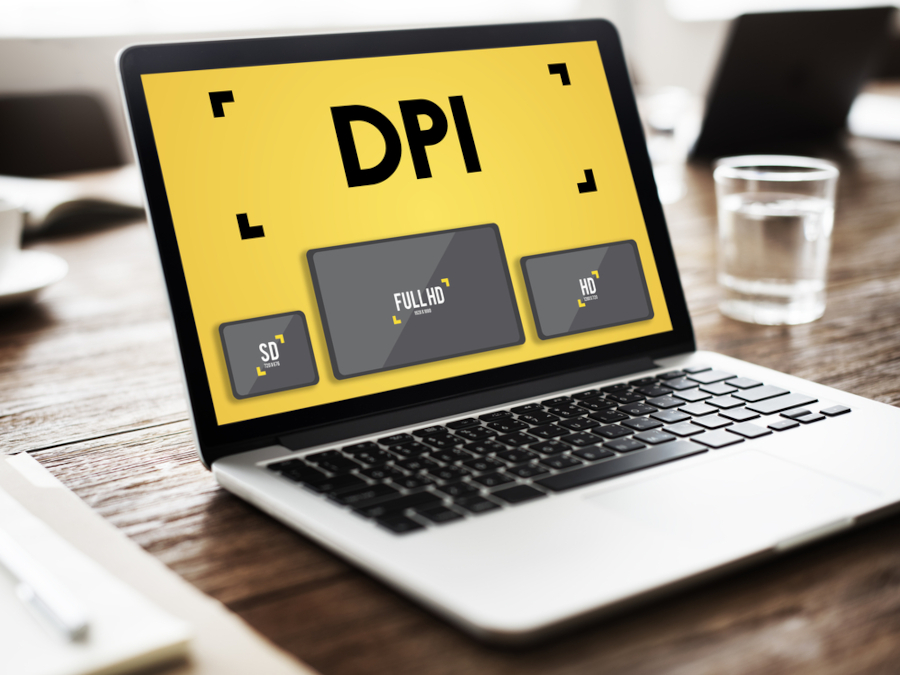The concept of DPI is a relatively simple one in the worlds of design and print, but it gets confusing quickly once we start diving into the details. And DPI is all about the details!
Essentially, DPI is a measurement that’s used to evaluate the level of detail that can be reproduced by a printer. The higher the DPI, the more information can be captured in print. A high DPI means the resulting print should have a higher resolution, appearing sharper and more detailed.
That isn’t the whole story though. The quality of the image that emerges from the printer is a result of much more than the printer’s DPI rating. Add to that the fact that DPI is often mistaken to mean “dots per square inch”, or “pixels per inch”, and it is clear we have some explaining to do. Let us start at the beginning.
What does DPI stand for?
DPI stands for “Dots Per Inch” and is used as a measure of the level of detail reproduced in an image or by a printer.
The term “dots” refers to the dots of ink applied by a print device. Dots per inch refers to a measure of how many of those ink dots are applied along an inch-long line of the printed material, also known as ‘dot density’. It gives a good indication or the sharpness of detail that can be achieved by that print device.
What is DPCM?
DPI stands for “Dots Per Centimetre”. As you might expect it is the metric equivalent of DPI. Despite the practicality of DPCM, it is not a widely adopted term and DPI remains the industry standard measurement for dot density.
How does DPI affect resolution?
Digital print is an optical illusion. For the print to be successful, we need to present a matrix of dots that’s fine enough to fool the human eye. Viewers must think they are seeing a representation of something they might see in real life. Something that consists of continuous lines and images, rather than a dotted pattern.
To achieve that, certain conditions must be met. The density of dots, the size of the image, and distance from the observer must all be in the right range for our illusion to work. That’s where DPI comes in. It is a handy measurement for us to use when judging how finely we need to print so that our images to appear smooth and detailed in context.
Is dot density measured over one dimension or two?
DPI is sometimes presented as a single number like 1200dpi. Elsewhere, you might see the same measurement written as 1200 x 1200dpi.
That’s because DPI for printing refers to the number of dots that appear along an inch-long line, not within a square inch area.
1200 x 1200dpi is a more complete way of expressing dot density, as it is a measurement that refers to area. The two numbers together give us dots per square inch. We need the horizontal and vertical measurements to make sense of the quantity and arrangement of dots within a 2D square.
However, where the two values are the same, the number is often stated just once. 1200dpi becomes shorthand for 1200 x 1200dpi.
But those two numbers are not always the same! Some inkjet devices may have a different DPI in the horizontal direction compared to the vertical. Where a print head moves across a page, the printer might apply more dots per inch across that axis. This is helpful in distributing and blending its limited number of inks more precisely to reproduce colours more accurately. Many high-end home and office desktop printers that boast ‘photo quality’ results, for example, might print at 5760 x 1440dpi, 4800 X 2400dpi, or 9600 x 2400dpi.
So, to give a full story about the print density, a measurement of DPI in two dimensions should really be expressed as a pair of numbers.
DPI vs PPI
That’s all very well when it comes to printers, but doesn’t DPI have something to do with digital graphic design and the size of image files?
This is where the confusion comes in with a related but different concept called PPI, or “Pixels Per Inch.” DPI is all about dots of ink, but electronic screens, image files, and digital camera sensors all work in pixels. DPI is how we measure the density of pixels, rather than ink dots.
It doesn’t help that people often say DPI to refer to a digital image when what they really mean is PPI.
Most designs that end up in print start life on a computer. If we want a high-resolution result in print, we need a high res digital image to start with. The problem with high-resolution digital imagery is that it involves a huge amount of information. This leads to large files that take up space, require a lot of processing power to manipulate, and are cumbersome to move around.
So, the balancing act becomes how we accommodate image files that do not overburden our computers but still result in high-quality print.
How ‘big’ does my digital image need to be?
When you consider how ‘big’ your digital image is, you might be considering one of three attributes:
- The total number of pixels in the image (which will be reflected in the file size)
- The resolution or pixel density which will be measured as PPI
- The physical dimensions of the picture it represents, which will be the total number of pixels divided by the PPI
PPI, which measures pixel density is only one aspect of a digital image’s suitability. Pixel density describes the relationship between quality and size, and those two factors interact with one and other. As size increases, quality decreases, and vice versa.
If you can imagine, an image made up of a finite number of pixels per inch. If you were to increase the size of that image in a design program, you would be stretching that finite number of pixels over a larger area. The dots per inch, along with the resolution and quality of the image, would reduce.
Conversely, if you have an image set up as A4 size in 72ppi and then alter the image to 300ppi, the image will reduce greatly in size. The two elements of the image, pixel quantity, and overall size are entirely dependent upon each other.
If your aim is to send an image to print and you wish to preserve your 300ppi picture quality, you need to ensure your resolution is set to 300ppi and your image size is set to represent the size of the finished product. Crucially, this needs to be set at the beginning of the design process, as detail cannot be added in later!
72ppi for screen, 300ppi for print, right?
That figure of 300ppi (often referred to as 300 dpi, as discussed) comes from the world of publishing, where we’re used to considering an image that’s printed onto something you can hold in your hands and observe at arm’s length. It’s a good rule of thumb when sending files to print to make sure they’re 300ppi or higher. Although for a printed element designed to be viewed from a distance, you could get away with lower.
72ppi is commonly taken to be the optimum resolution for images that appear on the internet. That’s because they’re large enough to look good on screen but compact enough so that the images don’t slow down the load times of your webpages.
So DPI is a simple measurement, but one with a number of far-reaching implications for design and print. If you are still struggling with how to make sure your designs are print-ready or concerned about the resolution of your resulting print, our team is always happy to discuss your needs. Don’t hesitate to contact us on 01702 460047, via email or on LiveChat.




